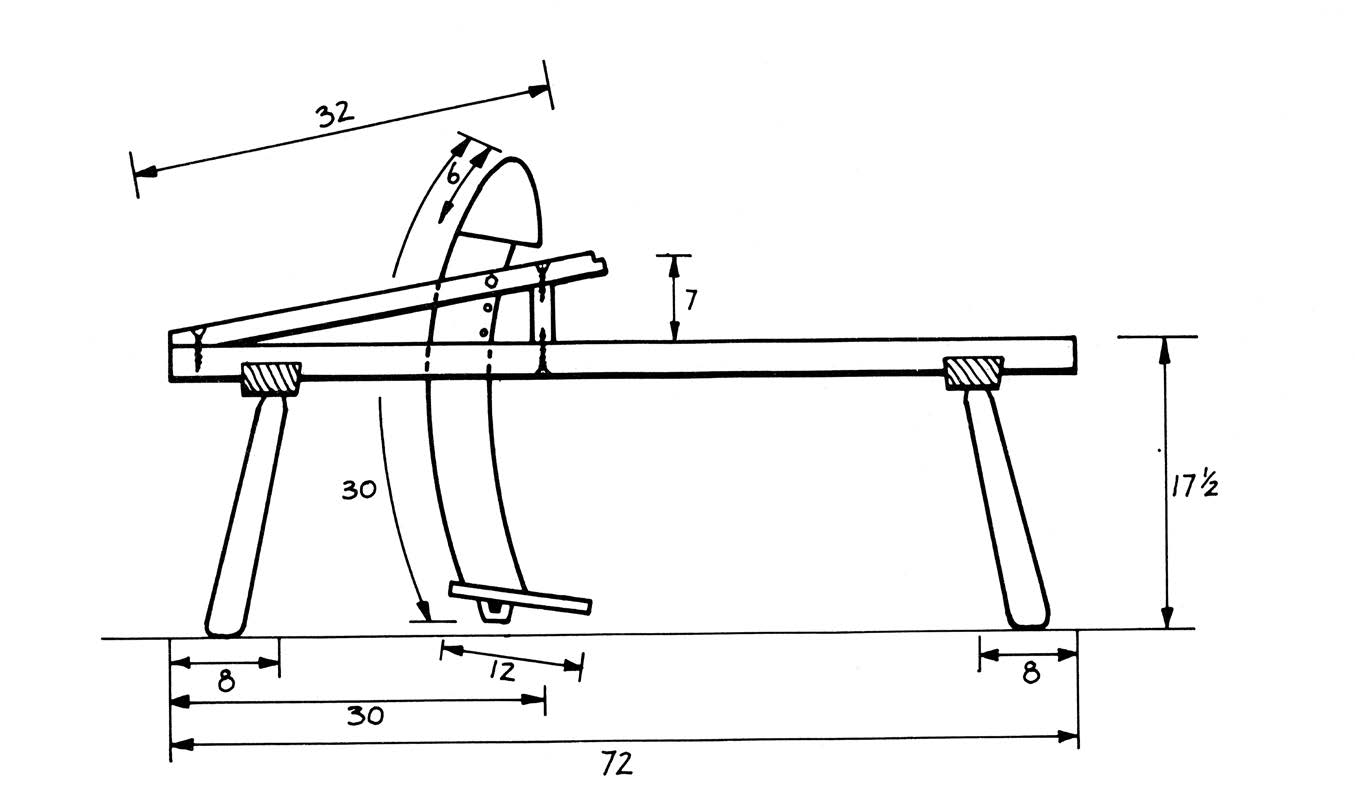
In 1978, Drew Langsner released his book “Country Woodcraft” to the world, and it sparked a movement – still expanding today – of hand-tool woodworkers who make things with mostly green wood.
The 304 pages of “Country Woodcraft” showed you how to split wood from the forest and shape into anything you might need, from a spoon to a bowl, from a hay rake fork to a milking stool, a pine whisk to a dining table.
After more than 40 years, Drew revisited this long-out-of-print and important book to revise and expand it to encompass what he has learned since “Country Woodcraft” was first released.
The result is “Country Woodcraft: Then & Now,” which has been expanded by nearly 100 pages and has been updated throughout to reflect what Drew has learned since 1978. Among many other additions, it includes greatly expanded sections on building shavehorses, carving spoons and making green-wood bowls.
The original book’s text is intact, and the old photos are in black and white. Throughout the book, Drew has added text, which we set in a slightly different font, to explain what he does differently now after 40 years of daily work on the North Carolina farm he shares with his wife, Louise.
In many ways, the book is a delightful conversation between the younger Drew, who is happy to chop down trees with a felling axe, and the older Drew, who now uses an electric chainsaw and band saw to break down stock to conserve energy (and likely aspirin). New illustrations and color photos throughout show how Drew works now.
Below is an excerpt from one of the new sections.
______________________________________________________________________________________________________________
During Country Workshops’ early years it seemed that we were always making shaving horses. We needed a herd for classes, and we offered courses in making them. These were mostly based on the design for Reudi Kohler’s shaving horse from the Swiss Alps. The Swiss-German name is a zug stuhl. In English, single-lever horses are sometimes called a dumb head.
At about that time, post-and-rung chairmaker Brian Boggs was experimenting with shaving horse possibilities derived from the British tradition where the mechanism consists of two pivoting levers that straddle the bench and work support. A cross-wise clamping bar connects the two levers at the upper working end. The foot pedal is another crosspiecethat holds the assembly together at the lower end. This type often has three legs – good for stability on a rough, uneven floor. The double-lever version is sometimes called a bodger’s horse. (I discuss the bodger myth in Chapter 12: A Spring-Pole Lathe.)
The distinctive feature of Brian’s shaving horse is a vertical ratchet system, for quickly adjusting the space between the work support and the jaw. The mechanism – sometimes called a wagon jack – was a breakthrough in shaving horse design. Brian also included a rotating jaw. This greatly improves clamping efficiency compared to the more common fixed cross-bar.
The immediately appreciated advantage of the ratchet is that it works quickly and easily. Less obvious is that the user now decides what height and angle is best for efficient tool use. The work support is lowered when working thicker stock. You select the height that your arms like, not the stock thickness. You always have optimal ergonomics. In contrast, with dumb-head shaving horses, the height of the jaw is adjusted for material thickness. With a thick chunk of wood you need to raise your arms to a position that often isn’t efficient body mechanics.
Also pre-Brian; the work support on twin-lever shaving horses usually pivots at the front of the bench. The work support is commonly adjusted with a wedge between the bench and lower surface of the work support. Consequently, the work support angle changes as the work support is adjusted for the stock thickness. With thin stock you need to pull upwards – uncomfortable and inefficient. And with thick stock you’re almost pulling the drawknife into your thighs.
A common disadvantage of traditional twin-lever horses is that the holes for the pivot bolt go through the bench – close to midpoint of the levers. The leverage ratio is inferior to the single-lever horses which have the pivot hole near the lever head. On dumb-head horses there is a further adjustment – additional bolt holes in the lever. On the bodger versions this adjustment is possible if the cross-bar can be moved up and down. When you do this, you need to adjust your arm height – possibly to an uncomfortable and inefficient working posture.
On most traditional bodger’s horses the cross-bar is fixed to the twin levers. The cross-bar doesn’t grab the work very well, due to a lack of bearing surface. Remember the poor leverage ratio caused by the low position of the pivot. This limitation can be overcome with a cross-bar that rotates. Now the cross-bar lies flat on the work.
A potential disadvantage of this feature is that the twin-lever unit isn’t as sturdy as it is with a fixed cross-bar. However, that can be overcome by stiffening the twin-lever unit at the lower foot end. With a rotating cross-bar, you gain so much holding friction that the poor location of the pivot becomes irrelevant.
Now we’ll look at design details with the single-lever dumb-head shaving horses. Because of the need to shave wood of various thickness there is no perfect shape for the lower bearing surface of the jaw. (This is the same problem as the fixed cross-bar in twin-lever horses.) This can be partly overcome by inserting something under the jaw or on top of the work support that increases grabbing strength. Reudi Kohler would use a piece of sandpaper, folded in half with the abrasive surfaces exposed.
A significant advantage found on most dumb-head shaving horses is the lateral foot treadle, rather than the foot cross-bar on bodger’s horses. The treadle eliminates the need to extend your legs nearly as far as with the cross-bar. Tall, leggy people don’t seem to understand this. I think the treadle is required.
One winter Carl Swensson decided to study shaving horses. (He wanted to design, make and use the best shaving horse possible.) Carl worked with the single-lever version, which is somewhat better for cooperage, which is what he was doing at the time.
I had always assumed that a shaving horse works because the head/ jaw comes down onto the workpiece, pinching it in place. Carl found that pinching doesn’t work very well. This is particularly true with dumb-head horses where there’s a compromise shape on the bottom of the jaw – it doesn’t lay flat on the workpiece.
Carl found that either type of shaving horse works much better when the jaw opening is adjusted so that there’s very little downward movement. The jaw moves in an arc, from about 12 o’clock to somewhere between 1 and 3 o’clock. When the jaw is adjusted to connect high in the arc, it’s moving at a low angle. Now it’s jamming, not pinching. You can’t pull the work loose, even with slight pressure at the foot treadle. It’s grabbing more like a wedge, not a connector like a clamp pad. An additional benefit of the close jaw opening is that there’s no need to press very far at the treadle, making life considerably easier. And work goes a bit quicker. The concept works equally well with dumb-head and bodger’s horses. It’s particularly effective when the bodger’s horse has a pivoting crosspiece. To increase friction with his dumb-head horse, Carl added a piece of semi-hard rubber on the bottom of the jaw.
Twin-lever horses win the efficiency contest because they can utilize a rotating crosspiece. On the dumb-head version the shape of the jaw is fixed, and is therefore never quite right.
An improvement that can be made with any dumb-head horse is to add more pivot bolt holes for adjusting the height of the jaw. The bolt holes should be spaced as close as possible. You can then adjust the height so that the jaw closes near the top of the arc, when it’s at a jamming angle.
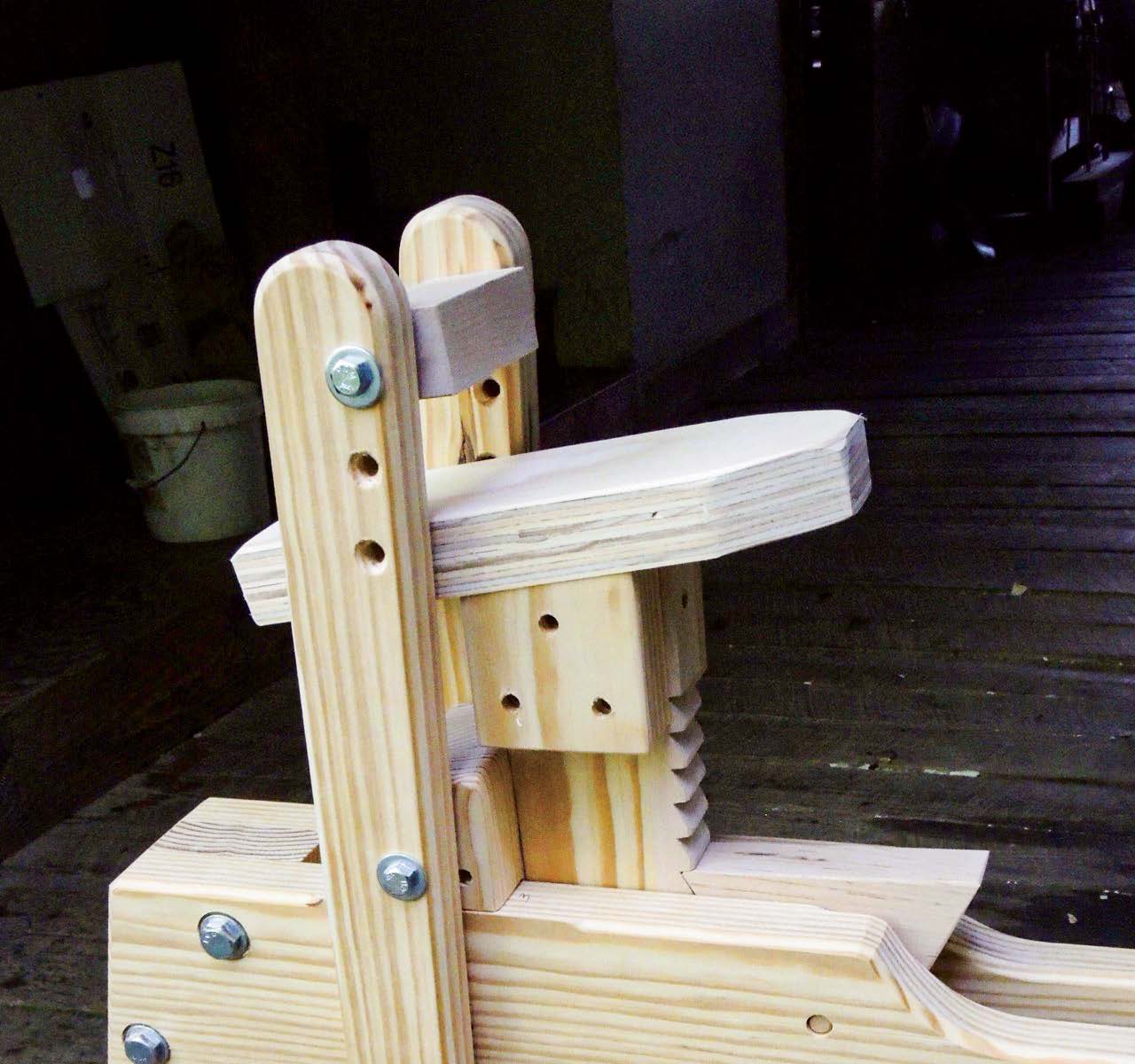
One year, chairmaker Tom Donahey asked if I would be interested in selling shaving horses through our Country Workshops Store. “Sure” was the quick answer.
Tom’s version of a twin-lever horse utilizes the ratchet work support. His bench design and other details are considerably different than Brian’s version. In early discussions I promoted a lateral foot treadle, rather than the foot cross-bar found on most bodger’s horses.
As with Brian’s shaving horse, Tom decided to drop the traditional flat bench – with four legs – in favor of a stiff frame consisting of twin 2” rails on edge, and three legs. The space between the rails conveniently locates the single front leg, the vertical ratchet part of the work support, and the wooden flipper device that engages the ratchet teeth.
We also wanted a wide, comfortable seat. But where and how should the seat be attached to the frame? We decided to experiment with adjustable seat positions. A small keel was attached to the underside of the seat for the prototype horse. The keel fits neatly between the bench rails. It turns out that there’s no need to secure the seat in place. You are you! The seat doesn’t want to move when you advance the treadle. The seat with keel remains – and now Tom’s shaving horse seats are upholstered.
Over time, other refinements were incorporated into the design. The bolt holes for the crosspiece were moved from the center of the levers to a location close to the aft edge. Moving the cross-bar aft helps when you need to work close to the mechanism, as with short stock, like a spoon blank.
We decided to call Tom’s version a shaving mule since it combines elements from so many earlier breeds of shaving horses, plus our innovations. Tom has made well over 200, and the mules were used at Country Workshops classes for many years. We also produced a set of detailed plans for DIY makers. I don’t know how many plans we sold, but some years ago we decided to put a free pdf download file on the Country Workshops website. This is currently available in the CW Archive section of my website, DrewLangsner.com.
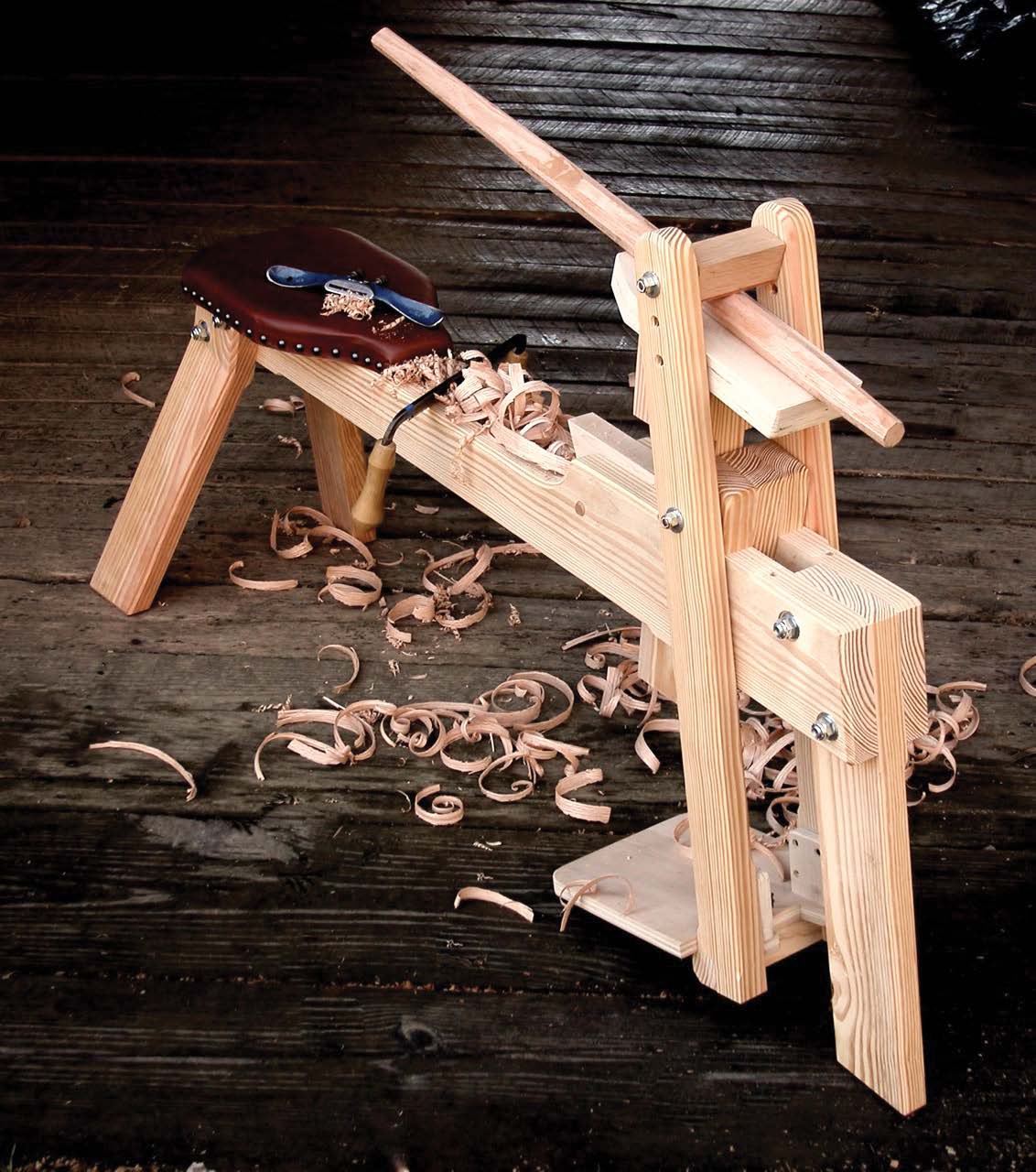
The Story Continues … During the Country Workshops years (1978 through 2017) I organized a series of international craft tours to Scandinavia, the U.K., Switzerland and Japan. In Japan I met Masashi Kutsuwa, a woodworker who teaches at Gifu Academy of Forest Science and Culture.
Masashi asked if I would be interested in teaching a post-and-rung chairmaking course. It would be run by the Japan Green Woodwork Association and take place at his school. Starting a chairmaking course isn’t easy. We would need tools and equipment, including 15 shaving horses. Masashi designed an easy-to-make twin-lever horse that can be quickly folded into a compact shape for storage. I loved teaching the class. But I didn’t like those shaving horses! (I won’t bother to discuss the problems with the design – trust me.) Something better would be needed for future classes. I promoted adopting Tom’s mules. Masashi countered that the design was too difficult for many woodworkers to construct. Also, he had to consider storage and transport – the Japan Green Woodworker group meets at different locations. But the real challenge with the Mule is making the precision ratchet mechanism. Tom’s design for attaching the rear legs also requires a compound-angled saw cut. It’s clever and works fine…if you can do it.
One day I received a booklet in the mail “Green Wood Work,” a Japanese primer for getting started with green woodworking. I could only understand the pictures – color photos and nice drawings. On page 25 my jaw dropped when I saw a new version of Masashi’s folding shaving horse. The significant innovation was that the work support was now two boards and two hinges that pivoted at opposite ends. The bench and work support make a “Z” configuration. The lower diagonal board raises and lowers the work support. The upper board’s hinge allows adjustments with the work support angle. Masashi’s new version also collapses into a compact bundle for storage and transport.
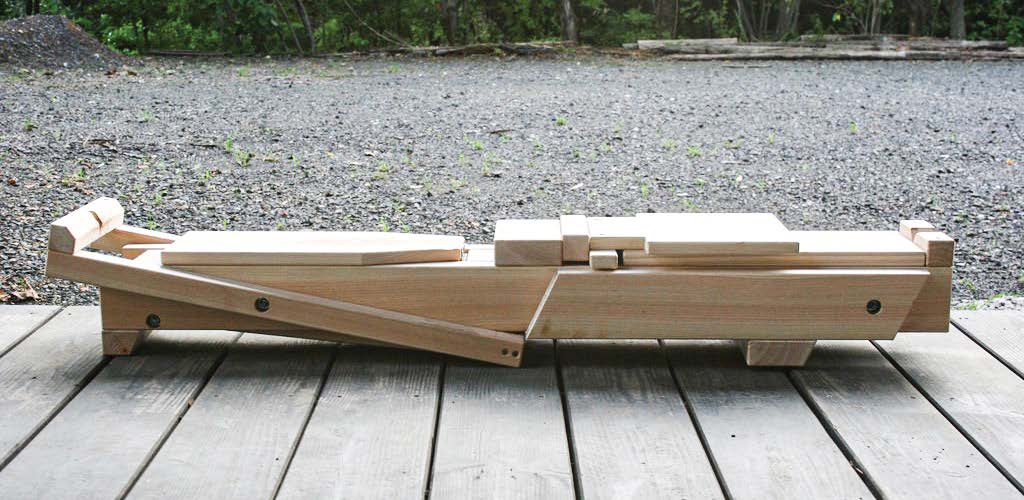
Here’s a way to easily set the work support at any height and at any angle. To keep things simple, the adjustments are made with loose wood blocks that act as wedges. I was also happy to see that the new folding horse used a lateral foot treadle, and a non-attached seat. The design still folds into a compact bundle for storage. My Japanese friends call it the Origami Horse.
I decided to make a Z-Mule that combines elements from Tom’s and Masashi’s versions, plus other elements. In this version, the diagonal of the Z is adjusted with a pivoting cam that stays in place better than a loose wedge. The holes in the cam look cool, but they’re really there to give you something to grab when adjusting the rotation. The diagonal and work support boards are attached with standard door hinges.
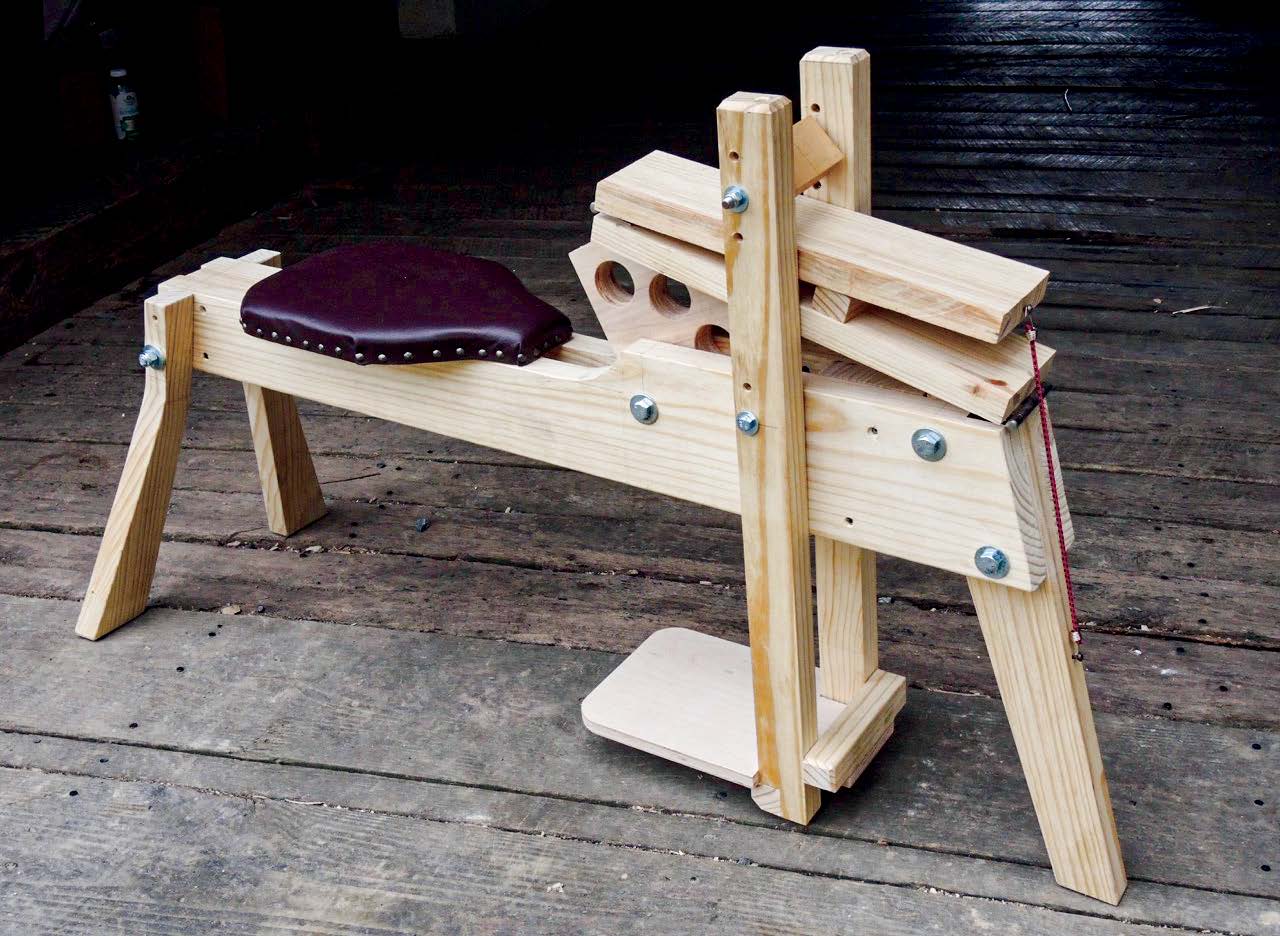
Masashi also came up with a clever way to attach the foot treadle; it simply lifts from the lever assembly when you want to knock the mule down for storage. I’ve kept Tom’s sliding seat. In this variant the rear legs are rotated 90° and are secured to the bench rails by nesting into channels cut into the sides of the rails. Easy to do and sturdy. I’ve also incorporated a rotating cross-bar. One further refinement is that the cross-bar is rectangular in section, not square. This provides another potential adjustment in the spacing between the cross-bar and work support.
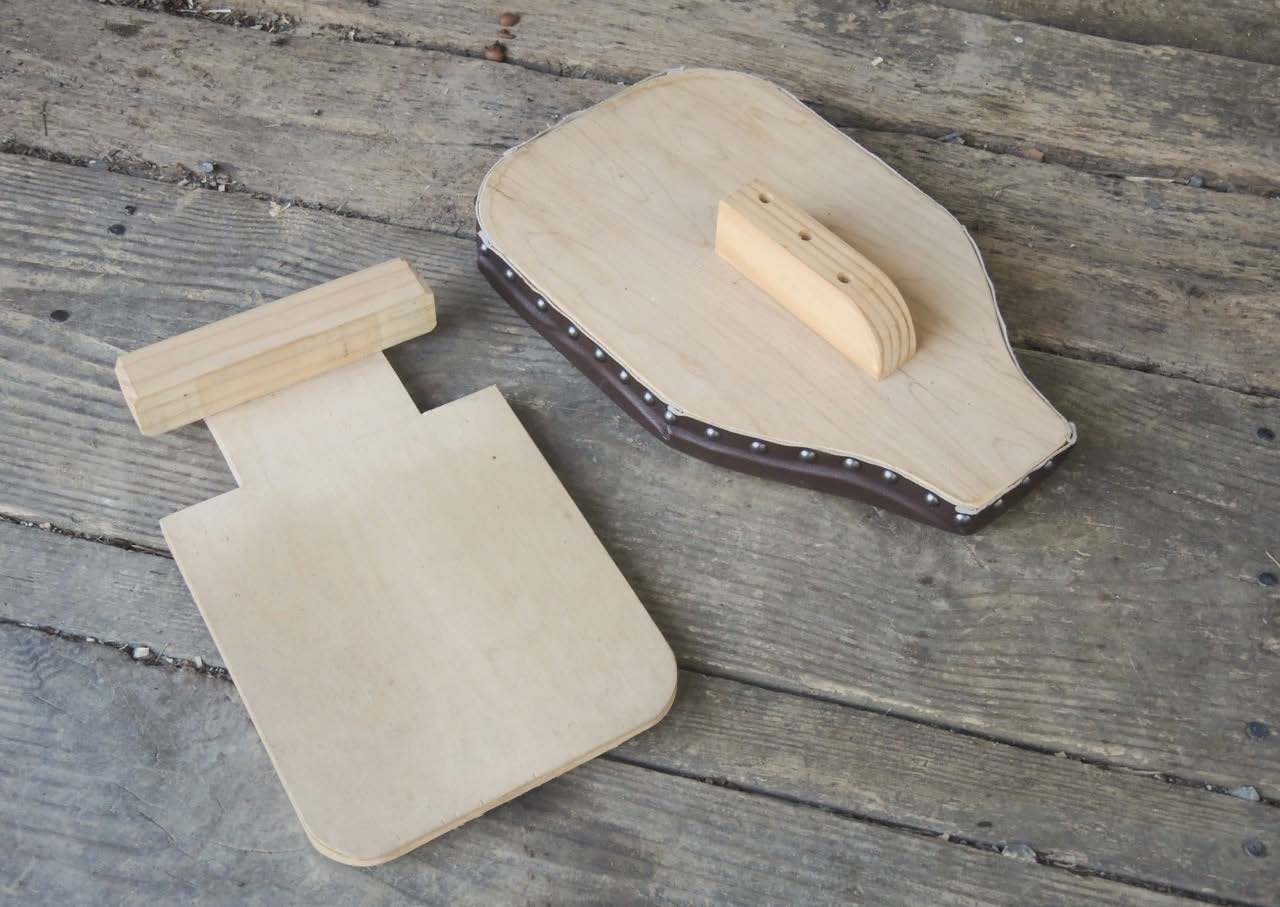
I decided to incorporate a few style touches. The Z-Mule is not purely a form-follows-function design. It needs to look good. The front leg tapers narrower toward the floor, while the rear legs taper larger. This may seem odd, but I believe that it looks right. Also, I thickness-planed the diagonal and work-support boards to 1-1/4″. An odd dimension, but another visual tweak.
Of course you can design and make your own version of a shaving horse. Please borrow freely from what I’ve shared about these wonderful, fun workshop critters.

This is so timely. Recently I’ve been learning about drawknives and shave horses (and all other species of similar critter). New knives vs. old. Bevel up and/or bevel down. And horses, so any types and styles and sizes and specific function models are out there to be built by us in our home shops. I found the subject of drawknives and shave horses can cause one to spend many, many hours learning and researching, but I’m finding that there is no need to drown yourself in details. Build a bssic horse that suits your eye and your skills, rehab an old knife or two or buy a decent new one like a Ray Ilse or Two Cherries, or Jason Lonon if you can swing the budget, and discover what you can do.
Several years ago I ordered the set of plans from Brian Boggs and built his shave horse out of select 2x southern yellow pine. It looks swell next to my Roubo Bench. The Boggs Shave Horse gets the job done.
Dear Drew,
in the post, you state that there are plans available for download on your website. Unfortunately, I have not been able to locate the download link there. Is it just me or is the link lacking? Any pointers would be much appreciated!
Best, Julius
Julius, the plans on the Country Workshops site aren’t up anymore. However, Tom Donahey has a video series on Youtube (he goes by “Chairman Tom”) that shows how he builds the horse, along with measurements for all the parts. There’s also a Popular Woodworking article “Modern Shaving Horse” that has plans and build notes for that horse design.
Thanks a ton, I will check those sources out, then!
If you go to https://web.archive.org/ and search for “http://countryworkshops.org/muleplans2013.pdf” you can find a copy of it.
Excellent! Thanks you very much!